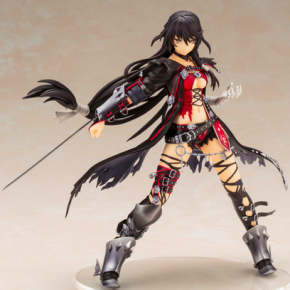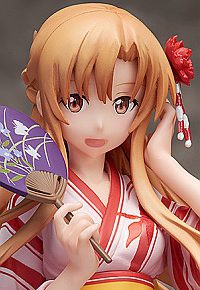 Felix Ho is the founder of Otaku HQ, an online website that specializes in PVC Figures, Action Figures and Model Kits with the latest news on new production runs and adjusted release dates from all the manufacturers. What began as a personal hobby for him has emerged into a business and an online following. Felix has been a frequent speaker at anime and manga conferences and festivals. Ricepaper decided to take some time to interview him for a better understanding of his quest to spread his passion.
Felix Ho is the founder of Otaku HQ, an online website that specializes in PVC Figures, Action Figures and Model Kits with the latest news on new production runs and adjusted release dates from all the manufacturers. What began as a personal hobby for him has emerged into a business and an online following. Felix has been a frequent speaker at anime and manga conferences and festivals. Ricepaper decided to take some time to interview him for a better understanding of his quest to spread his passion.
You present each year at the Anime Revolution. What do you present on? Why?
After working on Otaku HQ for close to 10 years, as well as being an anime fan since being a little kid, I am pretty much on top of all the latest PVC figure releases (I check all the official sites, plus any news and rumors sites daily, and being a collector myself). You can say I am practically a walking encyclopedia when it comes to these items.
Each year, February and July are pretty important for all figure collectors: KAIYODO’s Wonder Festival, is a 1-day event which showcase anyone who wants to make a figure out of any anime/game/manga characters, and for the past 10 years or so, most of the manufacturers in the figure industry have also been there to show their latest products and upcoming plans.
I did not plan on presenting in a panel setting at all when I started Otaku HQ, but in 2012 I started to have an itch to try it, with the local Anime convention scene gaining popularity (we have two anime-cons in Vancouver). I believed it was a good way to promote my site, as I have tons of traffic from the US, but interestingly not so much from Canada.
Timing is a big factor here, as the convention I picked to go, (Anime Revolution), normally runs in August, and Wonder Festival (Summer edition) is always set for the end of July, so it does give me a small window to gather all the new announcements from WonFes and present it in a panel format. I have tried to do Q&A panels in the past in other conventions, but I found people quickly lose interests and left early if I have nothing to present, and many people are actually pretty shy to ask questions, even if there are not that many people in the room. Last time I checked, I am probably the only one doing a figure-topic panel in Vancouver. You might be surprised to know that I am not really good at public-speaking, but doing this definitely helps me get better for my day job as a freelancer.

KOTOBUKIYA Tales of Berseria Velvet Crowe 1/8 PVC Figure
What is Otaku HQ? What does it mean? What is the website about? How does your website work?
Otaku HQ (http://otakuhq.com/) originally began as an anime news and affiliate site. I had a strong love and knowledge of anime. I probably know more anime titles than most Westerners, especially since some titles to date are still not licensed for North America. As I was doing anime reviews on my personal website for two years since 2004, I wanted to take the same concept and make some money out of it with affiliate marketing.
“Otaku” means people with obsessive interests in anime/manga/games (https://en.wikipedia.org/wiki/Otaku), and of course, kind of like the other famous word “NEET”, at first it was used as a negative way to describe certain fans. However, I just like the way it sounded, and it is a pretty accurate word to describe our passions, negative and all, so when I found out “OtakuHQ.com” was available back in 2006, I was really surprised. It is a great domain name and fit perfectly with what I wanted to do, and I don’t really care what the domain was used for beforehand, I just snapped it up and never looked back.
After launching the site in May 2007 (I developed the whole site from scratch for a couple of months), I knew I would have an identity crisis pretty early on. DVD sales from my affiliate channels at the time were not doing really great, and the amount of work that I had to put in for each anime titles was killing me. At the time there were not very many sites that were really dedicated to the figure side of things, so I started adding in the features that I needed for a PVC figures section on the site, and the rest was history.
Otaku HQ works pretty much like an e-commerce store except without any merchandise: it provides the latest information, and link out to our partner stores overseas. If our visitors click on a partner link and make a good purchase, we earn a commission. What makes us different at the time (and still is) is that we provide up-to-date release information for each figure, and if there is a change for the release date, you get it all from our news feed.
What makes us successful is the extra time I spent linking to my partner stores’ product pages directly from our product pages, making a seamless experience for our visitors. Most other affiliate sites will just link to their partners’ home page. Essentially we do all the work for you, just click and buy (unless you are looking for something else).
During the first few years, commissions were pretty meager (I did not spend a dime on promoting my site or run any SEO campaign, ever), only enough as extra pocket money (I couldn’t even cover my monthly hosting costs!) After 2011, the site traffic had increased enough that I can say I can definitely cover my hosting costs (not a small amount considering the number of pictures I have accumulated), and still have enough left-over for my hobby.
The past two years I even had enough extras to give back to the community by giving out some action figures of more well-known sci-fi characters (designed in Japan, of course) to the local chamber of commerce as prizes for their annual Christmas party, fundraising for local charities.

FREEing Sword Art Online II Yuuki Asuna Yukata Ver. 1/8 PVC Figure
What are anime figurines? Who’s usually interested in it?
The official word in Japan is “PVC Figure” (although it might sound really bad since PVC is not necessary environmental-friendly), essentially any characters from anime/manga/novels/game franchise can be made into a PVC Figure these days.
In the early days, there were no such things yet that resemble figurines. The closet thing would be resin kits that cost a lot; you have to paint them yourself, and productions are limited. Then in the early 2000s, KOTOBUKIYA, a company long in the business with plastic kits and resin kits, started releasing some of their resin kits as PVC Figures, and thus began the new era of figurine collectibles for anime fans.
When GOOD SMILE COMPANY started releasing their own products back 2006, the market started to have some healthy competition among the companies for high-quality products. Today, we have no less than 15 active companies releasing new items every month, covering characters from anime, manga and video games.
The market used to be male-oriented, with 99.9% of the figures made being female (after all, all otakus back then were males anyway). That changed in the past 6 years, with more male characters now being made for the ever-growing female audience.
What is the difference between manga and anime?
Manga, obviously, is in book-form with drawings in panels to form a storyline, be it short (four-panel) or long piece. Anime, of course, is animation created in the classic cell-drawing, frame-by-frame artwork. No computer graphics (but a bit more nowadays, especially for mecha or even the choreographed dance sequences for a certain popular idol franchise). It can be a short TV series (12 episodes), a movie, or even a direct-to-video release (that’s the origin for the term OVA and OAD).
These days there are not really much difference between manga and anime anymore. Many manga series are adapted into anime, and like-wise, many original anime series are also adapted into manga series as well. So to answer your question, it is just a difference in delivery format.
While we are on the topic, don’t forget the “light novels” too. They have become hugely popular ever since titles like Shakugan no Shana and The Melancholy of Suzumiya Haruhi were adapted into anime in the mid-2000s.
Why do you think grown men and women would be interested in manga and anime?

GOOD SMILE COMPANY Star Wars Nendoroid Darth Vader
From my experience, most people will move on to other things once they are older, and that’s natural for my generation and older, simply because there is still a stigma that watching anime/reading manga is for kids only (which is of course completely false these days), and once you enter the general work force, your co-workers may give you “the look” if they hear you talking about anime (especially those who never watched it and only spent time watching Simpsons and other cartoons). It might be cool to say you are a Star Wars/DC Comics/Marvel fans with my generation, but anime? Forget about it.
I already gave up on trying to convince those people that they are missing out a lot of good stuff (Hollywood is making their own Ghost in the Shell, did you hear??), simply because those already in their 40s and 50s pretty much have a firm mindset that anime equals immaturity. It might be true to a certain point, but I just hate it when I hear it.
I would say that younger American and Canadian generations might have the chance to break the cycle, simply because they actually had access to Sailor Moon, Dragon Ball and even Gundam Wing in the 90s; and with more quality shows being released on DVD/Blu-ray in North America, tons of Anime news sites, free video streaming from Crunchyroll, they simply have way more access to anime than you can imagine, at least compared to my childhood.
For people like me, it is a medium that we just grew accustomed to. Some people might like to watch TV sitcoms after a long day, I just happened to watch anime. There are tons of grown men and women in Japan who still watch anime and read manga, but not the rest of the world yet. It will be up to my generation and the younger ones in North America to make that a reality down the road.
For those who are new to it, what are some famous manga/anime that they must read/watch?
For anime, there’s quite a few I would recommend: Sword Art Online, Mobile Suit Gundam, The Legend of Galactic Heroes, Ghost in the Shell, Spice and Wolf, Irresponsible Captain Talyor, Tenchi Muyo!, Future GPX Cyber Formula, Clannad, Angel Beats!, ARIA, One-Punch Man, Girls und Panzer, A Certain Magical Index, Fate/stay night, Hayate the Combat Butler, Code Geass, Comic Party, and K-ON! (Is that enough?) For manga: Captain Tsubasa and Crayon Shin-chan.
Why do you think anime is so popular in not only Japan, but across the world?
Simply put, the Japanese have refined the art of cell animation. Americans might have invented animation, but it’s the Japanese who made it into a popular medium for storytelling targeting kids and then extending that to include every age group you can think of. The fact that anime already existed since the early 1960s, and within these 56 plus years, there are countless titles of anime you can watch, and they cover all kinds of topics. Sci-fi? Check. Love comedy? Check. Horror? Check. Slice-of-life? Check. Sports? Check. That’s why anime is popular around the world, because you can always pick a series that someone will like.
There are many types of anime/manga. What are your favourites?
Probably any genre, except shoujo manga (since they are for girls). I watched tons of mecha (Gundam Z and ZZ) and sports (Captain Tsubasa) early on, then got into action (Tekkaman Blade, Cyber Formula) when I was older. Once I hit puberty, I ended up watching quite a few harem titles (and I was lucky the genre was getting hot right after “Tenchi Muyo!”), then in the 2000s we got a lot of anime adaptation on numerous ero-games (Brighter than dawning blue, ToHeart2, etc), and of course the rise of the light novels (Suzumiya Haruhi, Shakugan no Shana, A Certain Magical Index).
Manga, on the other hand, I do have a really narrow range. I grew up reading Captain Tsubasa in Japanese (really!!), never completed it though (I ended up watching the anime), but my favourite for the past 10 years was anything by Akamatsu Ken (Love Hina, Negima!, UQ Holder!), School Rumble (the English version was never completed, by the way), Suzuka (hate the translations though – too many “f” words), and Hayate the Combat Butler (only got interested because of the anime).
There is a new one that caught my eyes right now: Kishuku Gakko no Juliet (http://www.shonenmagazine.com/bmaga/juliet), and I certainly looking forward to reading it.

ALTER World Conquest -Zvezda Plot- Lady Plamya 1/7 PVC Figure
What are the weirdest genres of manga you know of? Like Yuri (https://en.wikipedia.org/wiki/Yuri_(genre). Why do you think such manga exists?
The Japanese are known to have very liberal views towards porn, and interestingly a fetish-like appetite for boys-love (BL) manga in recent years (thanks to tons of doujinshi – unofficial original works of famous anime characters – getting all over each other). Both BL and Yuri have their own following, and as long as there is demand, these genres will be staying.
What do you think the future of anime/manga will be like?
While there are some in the anime industry these days having some negative views on some of the works that are out there, I do believe anime and manga, as a medium, will continue to evolve as time changes. On anime, throughout the years I have seen the rise of the “hero robot” genre in the 1980s, “cute girl fighters” and “harem” in the 1990s, light novels and ero-game adaptations galore in the 2000s, and more female-oriented genre in the past couple years. Throughout all these, there are still a huge variety of different series every year to satisfy your own particular taste. As for manga, as long as the doujinshi market is not crushed by the Trans-Pacific Partnership deal (some recent up-and-coming manga-ka got their starts doing doujin in Comiket), you will always find something you will like.
[aesop_gallery id=”12462″]